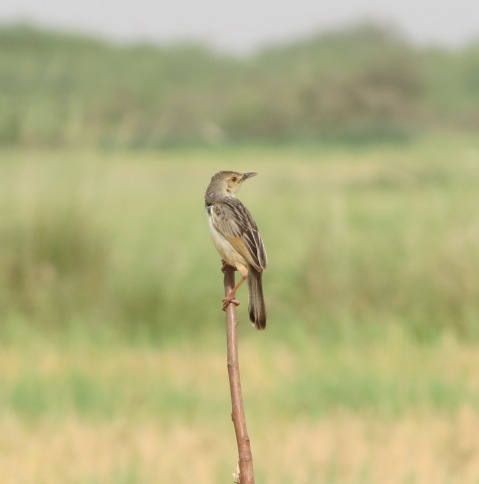A new window for seabird observations
After a few pleasant months in the busy central Dakar Plateau, generally referred to as “en ville”, I have decamped to Yoff Virage and a studio with stupendous roof terrace views obliquely towards the classic seabird observation point of Ile de Ngor (second image) and directly into the Atlantic (first image). I am 200m from a headland that is probably quite as good as Ile de Ngor for seabird migration, though lacking the raised views from that island’s cliffs, so this blog is likely to record my shuffle between Technopole and the Atlantic Ocean during the periods I am in Dakar.
Prior to the move, a whistle-stop tour of the Sahel during 12-16 October was motivated by ornithological projects, but with little time to birdwatch, other than from the vehicle window and then often during the mid-day heat when most birds are sensibly hidden within the shade at Sahel latitudes. Highlights were a brief flight view of an Arabian bustard at the Ndiael reserve and then, between Richard Toll and Dara, within the Six Forages sylvo-pastoral reserve, a male pallid harrier and an immature red-necked buzzard. The latter was the commonest raptor when I visited the Senegalese Sahel further east, around Linguere and Barkedji, just after the rains in 2012. The species is central and west Africa’s common forest bustard and the standard Senegal description is of it as a rainy season visitor even to the SE around Niokolo Koba, 300km south. Morel had a couple of observations during the rains near Richard Toll in the 1960s-70s. There seems to be a larger movement of birds north in this period than previously noted in this little-watched part of Senegal.
Two seasonal spectacles impressed my visitors during the tour. At dusk thousands of straw-coloured fruit bats, another species which shifts north with the rains, streamed out of St. Louis old town and across the river, presumably to orchards, providing a fine back-drop to sun-down drinks on a hotel roof terrace. This is the same bat species currently in Dakar. It is IUCN Red listed as Near Threatened, apparently due to its widespread capture for bush meat and medicinal use within the Central and West African forest zone, though this appears to be a perceived rather than quantified threat. I have no idea if the species is similarly used here.
Further north, on the east banks of Lac de Guier, another dusk gathering was of thousands of sands martins on overhead electricity wires east of the lake, probably waiting to descend into a nocturnal roost within the extensive reedmace Typha fringing the lake.
Paul
ps WordPress, the free blog hosting service, has just decided that advertisements will be permitted on blogs, unless one pays for them to be removed. Whilst I decide whether to pay or move the blog elsewhere, apologies for any inconvenience.
Lac de Guiers 31 July
 Today was my second visit to the delightful Tocc Tocc reserve and its neighbouring village, Pakh. With the rice harvested and the fields drained, though soon to be re-flooded for the second sowing, there were fewer waterbirds. Still, the three marsh terns (black, white-winged black and whiskered) flew over the lake and several river prinias were singing from the lake margins. Winding cisticolas were still territorial over the harvested fields and several small groups of zebra waxbills feeding in the field edges were an exciting find. I have only otherwise seen this species at Djoudj. A nervous flock of c300 lesser flamingos provided the day’s photo opportunities, flying with one black-tailed godwit in the picture above. These numbers are the largest I know of in Senegal away from Djoudj for this Red List “Near Threatened” species.
Today was my second visit to the delightful Tocc Tocc reserve and its neighbouring village, Pakh. With the rice harvested and the fields drained, though soon to be re-flooded for the second sowing, there were fewer waterbirds. Still, the three marsh terns (black, white-winged black and whiskered) flew over the lake and several river prinias were singing from the lake margins. Winding cisticolas were still territorial over the harvested fields and several small groups of zebra waxbills feeding in the field edges were an exciting find. I have only otherwise seen this species at Djoudj. A nervous flock of c300 lesser flamingos provided the day’s photo opportunities, flying with one black-tailed godwit in the picture above. These numbers are the largest I know of in Senegal away from Djoudj for this Red List “Near Threatened” species.
Canada via Lac de Guiers
I started writing this post four weeks ago at the end of the Birdlife congress in Ottowa. Senegal does not yet have a national partner organisation, but NCD is working towards that objective. It was an honour to represent them.
 Ottawa river. Cross it from left to right and one is in Quebec where French becomes the official language, permitting the French contingent at the Birdlife conference to bring up every cliché concerning francophone virtues.
Ottawa river. Cross it from left to right and one is in Quebec where French becomes the official language, permitting the French contingent at the Birdlife conference to bring up every cliché concerning francophone virtues.
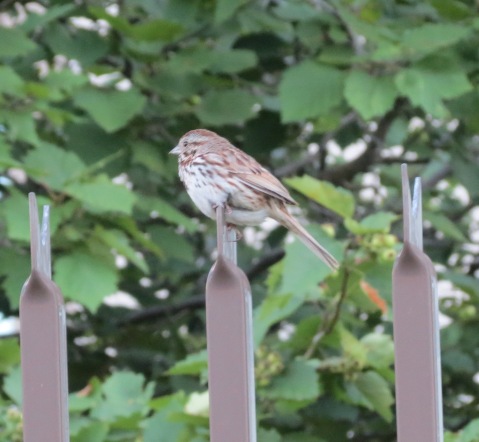 Song sparrow on the railings during the walk between the university halls of residence and the conference center, which was as far as most days’ birding went.
Song sparrow on the railings during the walk between the university halls of residence and the conference center, which was as far as most days’ birding went.
 Eastern kingbird, in the wooded slope in the foreground of the top picture of Ottawa.
Eastern kingbird, in the wooded slope in the foreground of the top picture of Ottawa.
My tenuous birding link is to point out that no north american passerine has yet been found in Senegal, though surely some must have jumped cruise ships unnoticed.
The long trip from Senegal to Canada started for me at Lac de Guiers Important Bird Area. Despite being not far from the sugar cane town of Richard Toll, this vast freshwater lake, the reservoir for Dakar, had up to the year 2000 been fully censused for waterbirds only once, in 1991. I am not aware that the situation has subsequently changed. The lake is fringed by reedmace, part of which comprises the new government wildlife reserve of Tocc Tocc; a Wolof name that describes a breach in the complex irrigation system around the lake that created a new channel and wetland. From my brief visit, in a month for which there is not much information anywhere in Senegal away from the coast on bird life, Tocc Tocc looks promising to include in Senegal River delta circuits. The edge of Lac de Guiers and many of the ditches, both covered in water lilies, had plenty of pairs of African pygmy-goose, often a target species for birders. The species is apparently abundant later in the year.
The irrigated rice fields were close to harvest and made clear that the main seasonal employment opportunity related to birds is Senegal is scaring them. Most fields had someone, apparently on a monthly 30,000 cfa, making assorted noises and movements to chase the diminuitive, colourful northern red bishops, yellow-crowned bishops and the notorious rice-pest red-headed quelea.
Winding cisticolas (above and below) sang from most fields, little bitterns seemed frequent and African jacanas were everywhere. The overall effect of working rice fields was colourful and picturesque, not ignoring the serious and exhausting work of rice cultivation.
Winding cisticola singing
Closer to the river, the reedmace fringing the ditches had two specialities in song; greater swamp warbler and the Sahel endemic river prinia (below).
 One can be lazy and say that a prinia in reedmace and looking rather greyer than tawny-flanked prinia is river prinia, but the real clincher is the song. So, for educational purposes, here is one of the briefest song recordings on the internet, but also as far as I can discover the only internet recording of river prinia. You heard it here first.
One can be lazy and say that a prinia in reedmace and looking rather greyer than tawny-flanked prinia is river prinia, but the real clincher is the song. So, for educational purposes, here is one of the briefest song recordings on the internet, but also as far as I can discover the only internet recording of river prinia. You heard it here first.
River prinia singing
Paul
Technopole 03 June
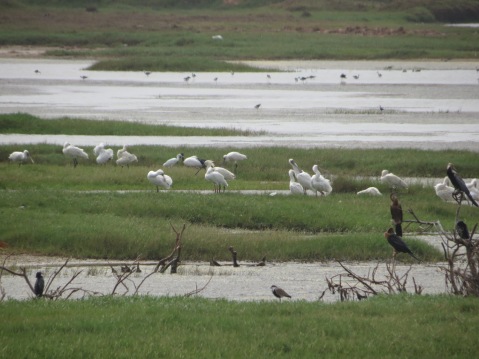 Today saw possibly the first June waterbird count for Technopole. Four species passed the hundred mark; white-faced whistling duck, pink-backed pelican, black-winged stilt and, much the most abundant, topping 800, little grebe. Looking at the available data up to 2007, this seems to be the largest, or second largest count of little grebe for Senegal. The Critical Sites Network website shows one count in the class of 200-20,000 (counts are not given precisely, but this seems an unusually wide class), also for Technopole. Today’s count is still a long way from the 1% threshold of international importance of 10,000 birds for the resident population south of the Sahara. The breeding dates gathered so far for Senegal suggest this is a non-breeding gathering.
Today saw possibly the first June waterbird count for Technopole. Four species passed the hundred mark; white-faced whistling duck, pink-backed pelican, black-winged stilt and, much the most abundant, topping 800, little grebe. Looking at the available data up to 2007, this seems to be the largest, or second largest count of little grebe for Senegal. The Critical Sites Network website shows one count in the class of 200-20,000 (counts are not given precisely, but this seems an unusually wide class), also for Technopole. Today’s count is still a long way from the 1% threshold of international importance of 10,000 birds for the resident population south of the Sahara. The breeding dates gathered so far for Senegal suggest this is a non-breeding gathering.
The photo above show that there is a pleasant mix of larger waterbirds: including black herons, eurasian and african spoonbills, yellow-billed storks and african darters. The eurasian spoonbills include a ringed Dutch bird. A young osprey, first seen in mid May and eating a fish both then and today at the edge of the NW lake, proved to have a Latvian ring.
 The gull and tern flock again held franklin’s gull. This is my first observation of the year, although one was picked up by a visiting birder on 16 April.
The gull and tern flock again held franklin’s gull. This is my first observation of the year, although one was picked up by a visiting birder on 16 April.
 It seems reasonable to assume that this is one of the three birds first seen in sub-adult plumage almost two years ago at Technopole and now in full adult plumage with white tips to the primaries. One wonders where they go when not here and if there have been any breeding attempts.
It seems reasonable to assume that this is one of the three birds first seen in sub-adult plumage almost two years ago at Technopole and now in full adult plumage with white tips to the primaries. One wonders where they go when not here and if there have been any breeding attempts.
Paul
Technopole at the middle and end of May
 A mid May visit to Technopole on 13th with visiting birder and bird photographer Sharad Sridhar considerably improved the recent quality of images on this blog. I will feature some more later, but here and below are an obliging immature red-necked falcon, a fairly reliable species here.
A mid May visit to Technopole on 13th with visiting birder and bird photographer Sharad Sridhar considerably improved the recent quality of images on this blog. I will feature some more later, but here and below are an obliging immature red-necked falcon, a fairly reliable species here.
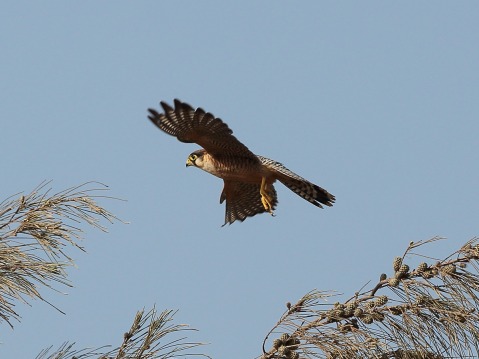 The dwindling number of Palearctic waders mainly comprised common ringed plovers. The birds here are actually more likely to be Nearctic birds, that is those from Greenland, Canada or (the minority just inside the Palearctic) Iceland. It should be possible to say which population, but here help is needed. The Nearctic birds, which common wisdom has are the main population wintering in West Africa, do not moult in the wintering grounds and this bird looks like its tertials are old, whereas the northern Scanadinaivan and Russian tundrae, more typically found in eastern Africa, should have moulted in Africa and have fresh plumage.
The dwindling number of Palearctic waders mainly comprised common ringed plovers. The birds here are actually more likely to be Nearctic birds, that is those from Greenland, Canada or (the minority just inside the Palearctic) Iceland. It should be possible to say which population, but here help is needed. The Nearctic birds, which common wisdom has are the main population wintering in West Africa, do not moult in the wintering grounds and this bird looks like its tertials are old, whereas the northern Scanadinaivan and Russian tundrae, more typically found in eastern Africa, should have moulted in Africa and have fresh plumage.
 Other northern hemisphere migrants were few, though a few northern house martins were a surprise. These are not a regular wintering species around Dakar and proved to be the first record for Technopole and species 192.
Other northern hemisphere migrants were few, though a few northern house martins were a surprise. These are not a regular wintering species around Dakar and proved to be the first record for Technopole and species 192.
New arrivals for May were also a few Eurasian spoonbills and African spoonbills. If last year repeats itself both species of spoonbill mysteriously appear together around now and depart towards the end of the rains 3-4 months later.
Copper Sunbirds were enjoying the Bougainvillia flowers.
Thanks to Sharad for all of this article’s gorgeous photos.
After a brief period away from Senegal, my next visit was on 31 May. Northern hemisphere waders were further reduced to just five greenshank and the first black-tailed godwit for a few months. The gull and tern flock is mostly slender-billed gulls, with one lingering black-headed gull, one gull-billed tern, three black terns and two common terns. A few northern house martins hawked with the resident little swifts.
Paul
Technopole 8 May and a Manx shearwater corpse at Ngor
 The abundance and diversity of Palearctic waders continues, as it should, to dwindle. This curlew sandpiper was the most interesting. Otherwise, last week’s little stints have left, common ringed plovers are now the only species in double figures and the rest were less than five each of greenshank, sanderling, common sandpiper and whimbrel. A summer plumage black-headed gull remains in the small gull flock.
The abundance and diversity of Palearctic waders continues, as it should, to dwindle. This curlew sandpiper was the most interesting. Otherwise, last week’s little stints have left, common ringed plovers are now the only species in double figures and the rest were less than five each of greenshank, sanderling, common sandpiper and whimbrel. A summer plumage black-headed gull remains in the small gull flock.
Of resident and inter-African migrants, the count of 7 African darters was higher than recently, long-tailed cormorants and little grebes, both in low hundreds, were the most numerous waterbirds. Sacred ibis and black heron remain, neither widespread birds in Senegal.

 A wander along the beach at Ngor produced this Manx shearwater. This is one of several shearwater species with a trans-equatorial migration route, using trade winds to ease flight, that takes is past Senegal in autumn and up the west Atlantic in spring, further explained here.
A wander along the beach at Ngor produced this Manx shearwater. This is one of several shearwater species with a trans-equatorial migration route, using trade winds to ease flight, that takes is past Senegal in autumn and up the west Atlantic in spring, further explained here.
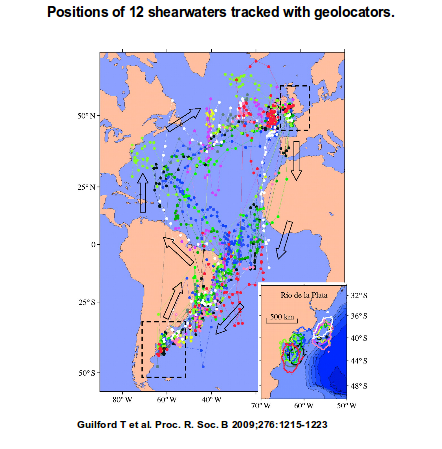 The looped migration from predominantly British and Irish breeding colonies hints that a spring bird here off Dakar is off course.
The looped migration from predominantly British and Irish breeding colonies hints that a spring bird here off Dakar is off course.
Paul






